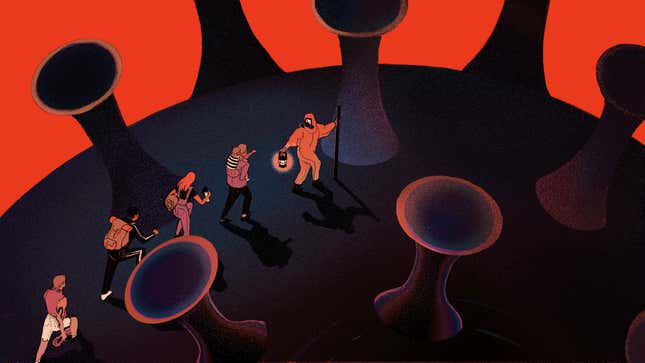
Illustration: Angelica Alzona/GMG
Last year, somewhere between story research and general curiosity, I found myself in Central Park with Shane Hobel, a compact and furiously energetic man who makes his living teaching other people how to stay alive. There were seven of us in his bite-sized “urban survival” course, for which Hobel travels down to New York City from the property outside of Beacon, New York, where the bulk of his work takes place. The thesis of the class appeared to be how ill-equipped any of us were to survive a major disaster or societal collapse. It was hard to argue with then and feels darkly accurate today.
I sat at a picnic bench between a pair of women in their fifties and a guy in a hot pink tank top sporting a gold watch. A man in a business suit played with his toddler in the grass nearby. “A lot of the people who come to this class are weekend warriors,” Hobel said. Most of everything we knew about being prepared for “an event,” he inferred repeatedly, was wrong. Our sense of observation had been dulled from years of overstimulation; tactical gear wouldn’t mean shit if we didn’t know how to move through a landscape undetected or come up with a cohesive plan for escape. If we were serious about the near-future anxiety implied by our willingness to part with $100 for an audience with a wilderness expert, we’d have to significantly expand our vision.
Hobel possesses skills and a kooky self-possession that have served him well as an ambassador between survivalists and city-dwellers concerned with their lack of tangible expertise. He’s been interviewed dozens of times over the years in every conceivable national outlet and has charged up to $15,000, he says, to help private clients create their own comprehensive doomsday plans. But like anyone who could be identified as prepping-adjacent, Hoebel told me more recently he’s had a big year, catering to a much wider clientele than the anxious Manhattanites who joined us in the park. “The people that are coming out now are the people that made fun of the people coming out” in the past, he says. The number of private groups he consults for or hosts on his property have sharply increased; he’s had multiple classes sell out.
It’s been a big year for the idea that Americans have a personal responsibility to expect and train for collapse. Through the spring and summer of 2020, as every newspaper in America offered shooting graphs tallying the number of the infected and dead, they also interviewed a rather remarkable number of preppers. A Utah couple described their pre-pandemic 90-day experiment subsisting solely on what they’d stored and could grow. A wealthy survivalist emailed a journalist from his bunker to say he didn’t “seem so crazy when there’s a pandemic, correct?” Nearly every accessible person with survival skills or a Youtube channel emerged to recommend a backup cooking system or brand of go-bag or ax.
-

-

-

-

-

-

-

-

-

-

-

-

-

-

-

-

-

-

-

-

-

-

-

-

-

-

-

-

-

-

-

-

-

-

-

-

-

-

-

-








































